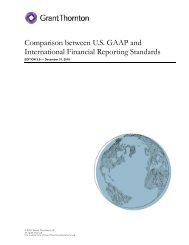CFOs: Surviving in a New Era - AGA
CFOs: Surviving in a New Era - AGA
CFOs: Surviving in a New Era - AGA
Create successful ePaper yourself
Turn your PDF publications into a flip-book with our unique Google optimized e-Paper software.
1<br />
executive summary<br />
The Association of Government Accountants (<strong>AGA</strong>)<br />
and Grant Thornton LLP have surveyed government<br />
chief f<strong>in</strong>ancial officers (CFO) s<strong>in</strong>ce 1996. The National<br />
Association of State Auditors, Comptrollers and<br />
Treasurers (NASACT) and the Government of Canada<br />
jo<strong>in</strong>ed us <strong>in</strong> 2008. The 2011 survey reports on 1,385<br />
onl<strong>in</strong>e and <strong>in</strong>-person <strong>in</strong>terviews with federal and<br />
state f<strong>in</strong>ancial professionals, <strong>in</strong>clud<strong>in</strong>g 38 Canadian<br />
officials. <strong>AGA</strong>, NASACT and Grant Thornton will<br />
publish a second report on state government <strong>in</strong><br />
August 2011.<br />
Risk management needs attention<br />
In times of tight budgets and shr<strong>in</strong>k<strong>in</strong>g staffs,<br />
effective management becomes critical. Small<br />
mistakes can multiply and have global implications.<br />
Governments need new solutions to<br />
survive and thrive – and <strong>CFOs</strong> have at their<br />
f<strong>in</strong>gertips the right concepts and processes for<br />
the challenge. One way is through effective risk<br />
management. When focused on core missions,<br />
risk management helps governments<br />
set priorities, avoid unneeded costs<br />
and deliver better services to citizens.<br />
Unfortunately, U.S. federal<br />
and state f<strong>in</strong>ancial executives<br />
and managers give a C to<br />
a B- grade on how well<br />
their entities <strong>in</strong>tegrate<br />
<strong>in</strong>ternal controls with risk<br />
management. F<strong>in</strong>ancial<br />
executives say that many<br />
non-f<strong>in</strong>ancial leaders and<br />
managers do not understand<br />
risk, either ignor<strong>in</strong>g it or<br />
becom<strong>in</strong>g so risk-averse as<br />
to paralyze operations.<br />
Governments need the f<strong>in</strong>ancial perspective on<br />
risk management that <strong>CFOs</strong> provide. F<strong>in</strong>ancial<br />
management leaders know how to handle f<strong>in</strong>ancial<br />
risks, but are usually absent from the operations<br />
or mission risk arenas. This is unfortunate<br />
because operations risks tend to cause f<strong>in</strong>ancial<br />
problems and vice versa. F<strong>in</strong>ancial executives say<br />
that recent budget shortfalls and cuts are caus<strong>in</strong>g<br />
new risks to government missions, to f<strong>in</strong>ancial<br />
management and to risk management itself. As<br />
f<strong>in</strong>ancial staffs get smaller, oversight decl<strong>in</strong>es and<br />
more th<strong>in</strong>gs slip through the cracks. Less money<br />
makes it difficult to start new activities, so <strong>CFOs</strong><br />
must become sales agents for better risk management<br />
efforts.<br />
Predictive and statistical<br />
analytics can deliver more value<br />
Predictive or statistical analytics or model<strong>in</strong>g<br />
uses data m<strong>in</strong><strong>in</strong>g, statistical analysis, game<br />
theory and geospatial analysis<br />
to extract <strong>in</strong>formation from<br />
data, and then applies it<br />
to predict<strong>in</strong>g trends<br />
and patterns and<br />
to identify<strong>in</strong>g
















